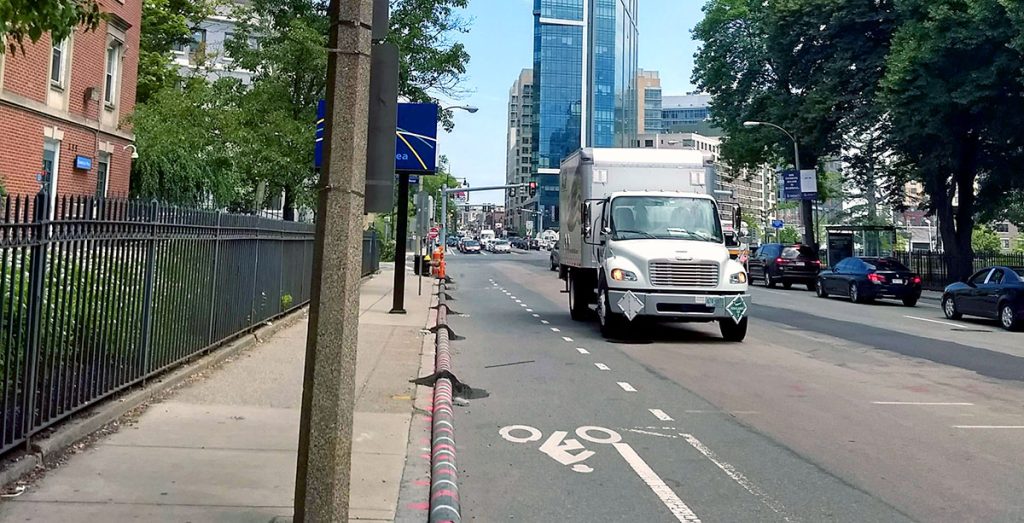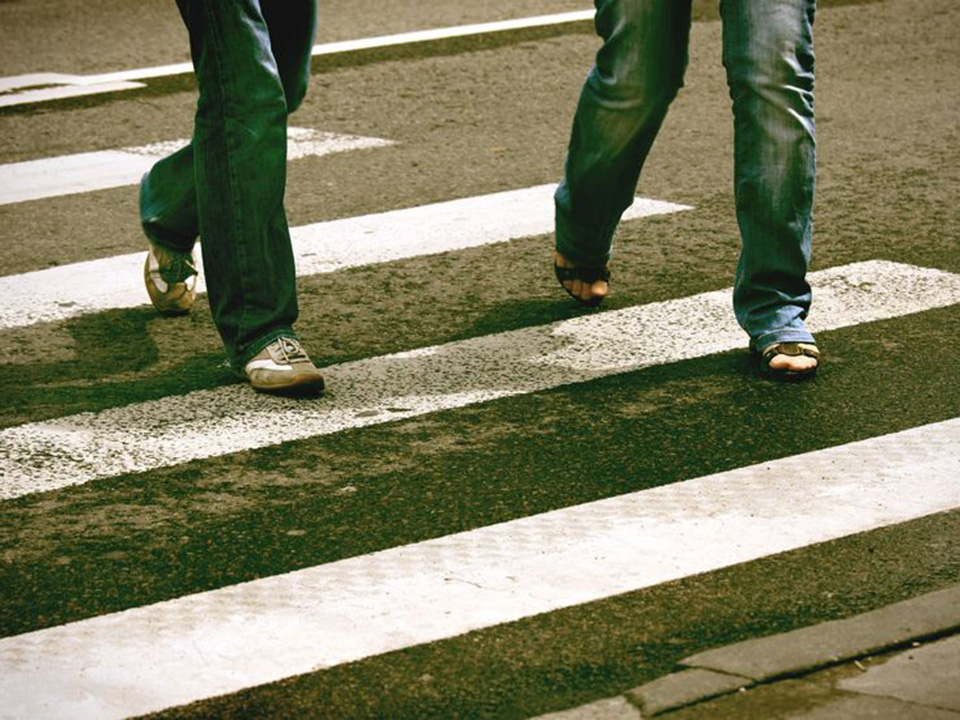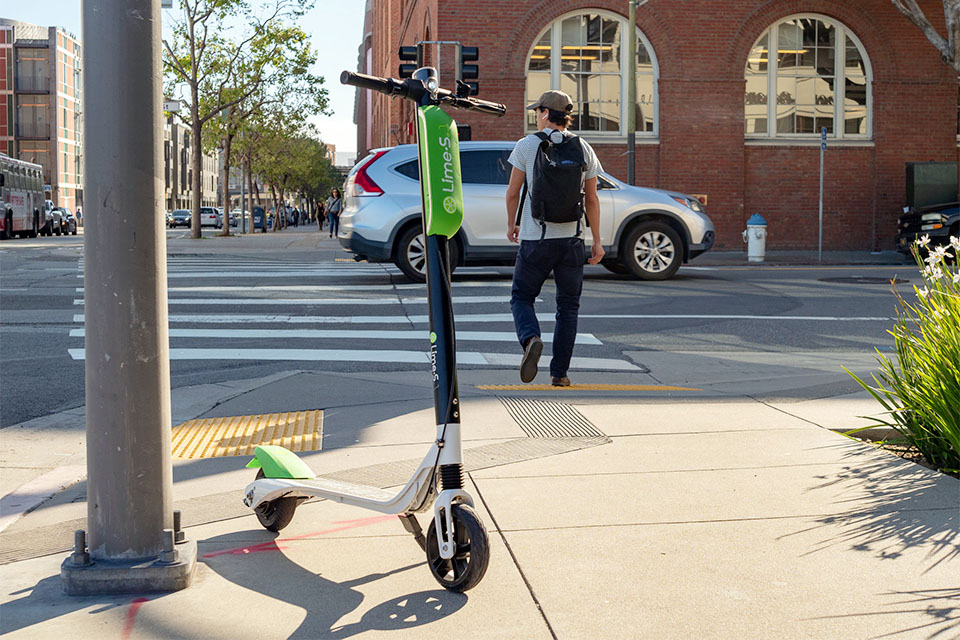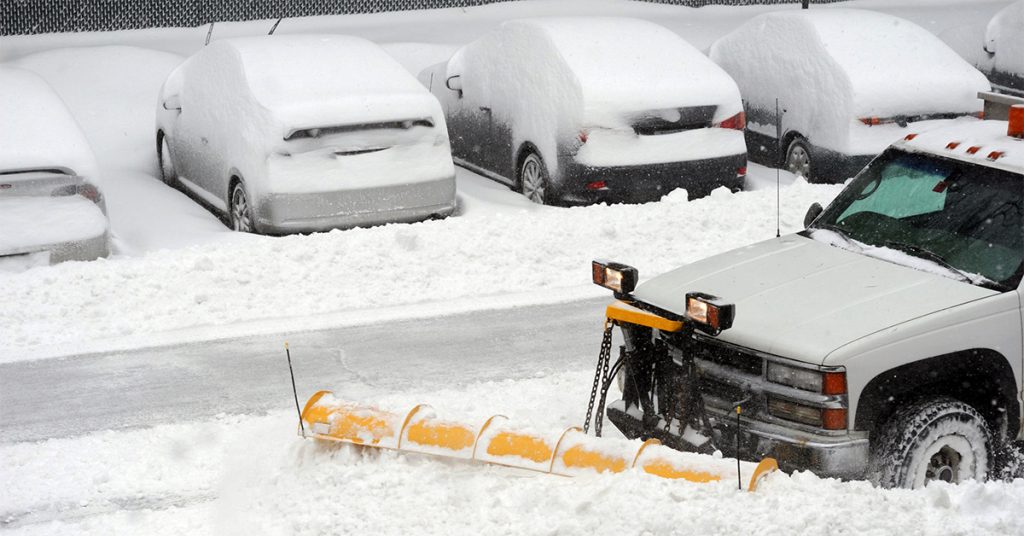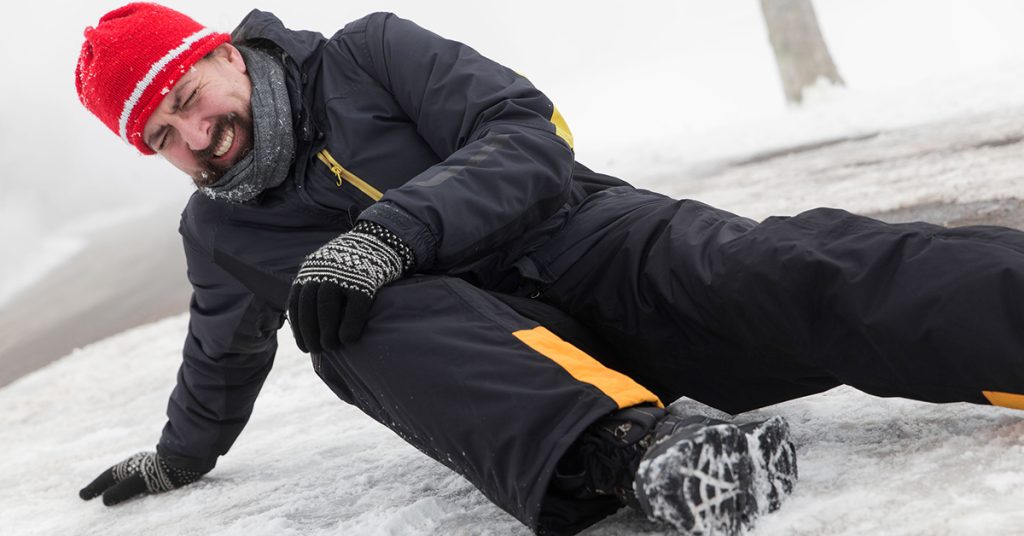Posts by Breakstone, White & Gluck
Trucks Remain a High Crash Risk for Cyclists in Boston, Across U.S.
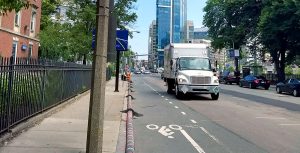
A truck travels along Brookline Avenue in Boston last summer, near the site of a fatal truck crash killing a cyclist last week.
It was heart-breaking to watch the TV news coverage last week, the scenes following a cement truck crash which killed a cyclist in Boston’s Fenway neighborhood. The 69-year-old victim, a librarian in Brookline, was hit at the intersection of Brookline Avenue and Park Drive on Friday afternoon.
As State Police investigate the fatal bicycle accident, we should all be concerned about trucks. If you are a pedestrian or cyclist in Boston or Cambridge, you have likely witnessed a truck crash or near crash. Or felt the sheer terror of a truck too close.
At times, it is hard not to travel in fear of trucks in Massachusetts, especially in Boston and Cambridge. One very upsetting moment came earlier this month, when a city truck reportedly plowed over a sidewalk in Chinatown, hitting a pedestrian. The truck ultimately smashed into the side of Liu Yi Shou Hotspot Boston, which is located at Washington and Kneeland streets, near Tufts Medical Center. The pedestrian was treated for non-life threatening injuries while the restaurant sustained heavy structural damage.
Because trucks are heavy-weight vehicles, drivers must be properly trained and use reasonable care when operating. Just as in Chinatown, truck crashes can cause injuries to pedestrians. Cyclists are also vulnerable, especially when crossing intersections near trucks.
In Massachusetts, the law specifically addresses a truck driver’s responsibility when making right turns at intersections near cyclists. Truck drivers must make the turn at a “safe distance,” at a “speed that is reasonable and proper,” according to the law. To do this in Boston, truck drivers have to check. Large vehicles are set up much higher than cyclists. Drivers need to use mirrors and specifically looking down at the bike lane before turning.
When a driver neglects to check, there can be serious consequences. They can end up cutting a cyclist off in a right hook accident. This can lead to severe injuries and often death.
Our attorneys have extensive experience in investigating truck crashes which have seriously injured or killed cyclists.
Last year, Attorney Ron Gluck of Breakstone, White & Gluck settled a wrongful death lawsuit on behalf of a cyclist who was killed by a truck driver in a hit-and-run crash. The driver hit our 38-year-old client at the intersection of Massachusetts Avenue and Beacon Street. Read about the case in Boston Magazine.
Truck Accident Statistics
- Nationwide, fatal truck crashes have increased by 3 percent, from 4,704 to 4,213, according to the 2016 Large Truck and Bus Crash Facts 2016 report by the U.S. Department of Transportation.
- Truck drivers were speeding in 6.9 percent of truck crashes involving a fatality. They were engaged in distractions in 6.1 percent of fatal truck crashes. Failure to yield the right of way resulted in 4 percent of truck crashes resulting in a wrongful death. These were the leading causes; violations were not reported in many of the accidents (2016 Large Truck and Bus Crash Facts 2016).
- In 2016, 840 cyclists were killed in traffic crashes, a 2 percent rise over 2015. More significantly, this continued a trend of near two percent increases and marked a 25-year high for fatal cyclist accidents in the U.S. Cyclists age 55-59 and 60-64 had the highest fatality rates. (Source: National Highway Traffic Safety Administration, Traffic Safety Facts 2016 Data: Bicyclists and Other Cyclists).
- Single-vehicle truck crashes killed 85 cyclists in 2016, just about 10 percent of all traffic deaths (NHTSA Traffic Safety Facts).
How Cyclists Are Being Injured By Trucks
When cyclists are killed in collisions with motor vehicles, they are most likely to be hit by the front of the vehicle, according to the NHTSA FARS data. Cyclists are hit from the front in 78 percent of all cyclist vs. motor vehicle deaths, including in 89 percent of accidents involving cars and 83 percent of accidents involving light trucks, SUVs, pick-up vehicles or vans.
The numbers change when you look at fatal accidents involving large trucks and cyclists. While 48 percent of cyclists who died were hit from the front of large trucks, 22 percent were struck by the right side of a truck, while 9 percent were hit on the left side. Another 7 percent were by the back of the truck.
Truck Sideguard Ordinances and Legislation in Massachusetts
Some cities and states want to encourage truck safety by passing ordinances that require trucks to be equipped with side guards. This covers the area between a truck’s wheels, where cyclists and pedestrians can become trapped. Two cities in Massachusetts have already passed ordinances for city-contracted trucks and large vehicles. The ordinances also require trucks to use convex mirrors to help them see blind spots.
Boston was the first U.S. city to pass an ordinance in 2014. Somerville has since followed, passing the Somerville Ordinance to Safeguard Vulnerable Road Users. A statewide law could be next. A proposal now on Beacon Hill is asking lawmakers to mandate side guards on all city- and state-owned vehicles by 2020. Contractors would be required to meet the new standard by 2022.
Free Legal Consultation: 800-379-1244
Breakstone, White & Gluck has more than 100 years combined experience representing victims in personal injury, wrongful death and medical malpractice cases.
If you or someone in your family has been injured, contact us today for a free legal consultation at 800-379-1244 or 617-723-7676 or use our contact form.
Police Investigate Truck Crash Which Killed Boston Cyclist in Fenway Neighborhood
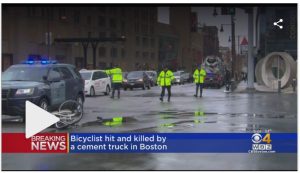 Massachusetts State Police are investigating a tragic crash which killed a female cyclist today in a heavily congested Boston intersection. The bicycle crash happened in the city’s Fenway neighborhood, less than a half mile from Fenway Park. Witnesses described a frightening scene as emergency responders attempted to resuscitate the woman, according to WBZ-TV. The woman was transported to Brigham & Women’s Hospital, where she sadly died from her injuries. The woman’s bike was left crushed in the road as State Police blocked off two traffic lanes to investigate.
Massachusetts State Police are investigating a tragic crash which killed a female cyclist today in a heavily congested Boston intersection. The bicycle crash happened in the city’s Fenway neighborhood, less than a half mile from Fenway Park. Witnesses described a frightening scene as emergency responders attempted to resuscitate the woman, according to WBZ-TV. The woman was transported to Brigham & Women’s Hospital, where she sadly died from her injuries. The woman’s bike was left crushed in the road as State Police blocked off two traffic lanes to investigate.
The cement truck reportedly struck the woman on Brookline Avenue at Park Drive around 1:30 p.m., according to Boston.com. Just before 4 p.m., State Police reported the woman had died. The cement truck read, “Boston Sand & Gravel Co.” The driver reportedly stayed on the scene and was also transported to a hospital for evaluation. At this time, State Police have not released the name of the woman, the driver or confirmed the cement truck’s owner.
News photos showed the truck crash that killed the cyclist was near a major traffic block, near Emmanuel College, Boston University’s Fenway Campus and the Emerald Necklace walkway. Nearby is Longwood Medical area, including Brigham & Women’s Hospital, Beth Israel Deaconess Medical Center and Children’s Hospital.
Police focused their investigation on the center of the large intersection, measuring marks in the road, according to WBZ-TV. The bicycle was crushed and the seat was detached. The cement truck remained on site for several hours before being towed away.
About Breakstone, White & Gluck
Breakstone, White & Gluck is one of the most respected personal injury law firms in Boston. With more than 100 years combined experience, our attorneys represent cyclists and their families in personal injury and wrongful death lawsuits. With a special expertise in investigating truck crashes and an expansive knowledge of the trucking industry, our attorneys have a record of successfully negotiating the best financial results for our clients. Time and again, we have effectively presented the evidence and negotiated the maximum coverage on insurance policies. If you have been injured, learn your rights. For a free legal consultation, visit 800-379-1244 or 617-723-7676 or use our contact form.
Breakstone, White & Gluck’s Experience
We invite you to read about one of our recent cases below or in Boston Magazine. Attorney Ron Gluck was recently interviewed about his work for the family of a cyclist who was struck and killed by a truck in Back Bay.
After Fatal Pedestrian Crash, City of Somerville Looks at Traffic Calming Measures
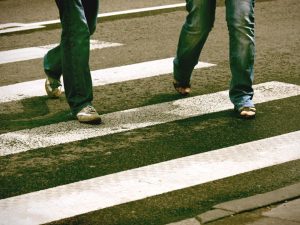
Somerville residents are asking for new traffic calming measures after a fatal pedestrian crash last weekend on Powder House Boulevard and Hardan Road. Police are searching for the driver, who fled the scene.
The Somerville community is wrestling with the horrific crash that killed a teacher in a crosswalk last Friday night.
Somerville Police are still searching for the driver in the Somerville pedestrian crash. The driver struck Allison Donovan, an educator in the Watertown public school system, shortly after 7 p.m. Friday, then fled the scene. Another woman in the crosswalk suffered non-life-threatening injuries.
As police investigate, city officials say a community meeting will be held to discuss accelerating traffic calming measures for the area. The pedestrian accident happened on Powder House Boulevard, at the intersection of Hardan Road, near the West Somerville Neighborhood School. In response to the crash, the city began setting up flex posts with neon reflectors Monday.
For the short term, Somerville Police will be there to assist students who are dropped off and picked up at the West Somerville Neighborhood School. Message boards are also being deployed in the area along with the flexposts.
But residents are now calling for more, including speed bumps to force drivers to slow down.
Traffic Measures to Change Driver Behavior
Communities can implement traffic calming measures to change driver behavior and improve safety conditions for non-motorized street users. Speed bumps and raised intersections are two examples of traffic calming measures. Other examples may include protected bike lanes and cycletracks which allow cyclists to travel inside curbing and away from cars, trucks and rideshare vehicles.
Different areas may require different traffic calming measures. Some communities may address a single intersection or street. But often, communities are working on larger areas.
Slower speed limits are another traffic calming measure. Boston, Cambridge and Somerville were among the first communities to reduce speeds to 25 mph a few years ago, when the state gave communities this authority.
In Somerville, city officials have already implemented many traffic calming measures, including on Powder House Boulevard, which has received physical and painted sidewalk bumpouts, improved crosswalk markings and flashing stop and crosswalk signs and vertical reflective crosswalk markers. In the City of Somerville’s online update, it also noted there is a flashing pedestrian activated crosswalk sign at the intersection near Hardan St. This is where the pedestrian crash happened.
But this spring, Somerville city officials had planned additional traffic calming measures on Powder House Boulevard, between Curtis Avenue and North Street (the fatal pedestrian accident happened in this area). Speed bumps and traffic tables were already on the schedule to be considered after the completion of bike lanes and sidewalk bumpouts. Now, city officials say they are seeking options to bring in speed bumps and traffic tables sooner.
About Breakstone, White & Gluck – Free Legal Consultation
The Boston personal injury lawyers at Breakstone, White & Gluck specialize in representing those injured by pedestrian accidents and other car accidents. Over the past three decades, our attorneys have helped pedestrians and their loved ones understand their legal rights and obtain the full compensation they need for their injuries. When a loved one is lost, a surviving spouse or the decedent’s children may be able to pursue a wrongful death claim against those who were negligent. Our attorneys are experienced in representing families in wrongful death claims in Massachusetts.
For a free legal consultation, call Breakstone, White & Gluck: 800-379-1244, 617-723-7676 or use our contact form.
New Report on Electric Scooter Injuries as Massachusetts Considers Regulations
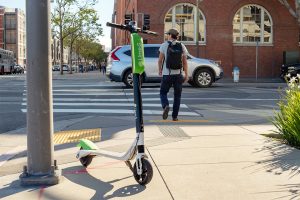
Electric scooter parked on a sidewalk. Seven scooter companies have expressed interest in coming to Massachusetts, according to the Metropolitan Area Planning Council (MAPC).
If proposed legislation passes, electric scooter rentals may soon return to Massachusetts. Bird – a start-up scooter company – flew in and out of the state last year on a failed test run.
Since then, many communities have been discussing regulations locally while waiting for action on the state level. Last month, Gov. Charlie Baker delivered, including electric scooters in his road safety bill, calling for regulations similar to bicycles. Like cyclists, scooter riders would be required to wear helmets to protect themselves from head injuries.
As it stands, electric scooters are regulated more like mopeds and must have blinker lights under M.G.L. ch.90 §1E. Bird did not equip their scooters with blinkers.
Bird caught Cambridge and Somerville off guard last summer, setting out dockless electric scooters on sidewalks for rent – without permission or any approval process. The cities responded with cease-and-desist letters. As Bird packed up its scooters, city officials began discussing how to regulate the scooters locally. But the conversation only went so far because of state law.
In its first year, Bird pushed hard into 100+ cities around the world, surpassing 10 million rides, according to Wikipedia. Bird left Massachusetts last year, but it’s likely to return one way or another. The company has taken legal action against Beverly Hills and other communities with scooter bans.
The Impact of Electric Scooters on Safety
The industry is closely following the proposed legislation in Massachusetts. In addition to Bird, six other companies, including Lime, Uber and Lyft, have expressed interest, according to media reports.
Scooters are the next step for rideshare and bike share companies (In fact, Bird was founded by a former Uber and Lyft executive; Lime counts Uber and Alphabet – Google’s parent company – as investors. And Uber and Lyft themselves are interested in their own right).
Scooters are an affordable way to travel, with rides costing even less than subway fare. Anyone with a mobile phone can sign up and unlock a scooter for about $1.00; from there, the ride is about 15 cents per minute.
Scooters may help alleviate some traffic congestion, but they will also increase pressure in many areas, such as Somerville and Cambridge, which have high counts of pedestrians and cyclists. Other states are seeing accidents and we will likely see more car accidents and truck accidents in Boston and across the state, regardless of the skill, leadership and collaboration local and state officials bring to the process.
Although companies may mandate helmet use in the fine print, many people will end up riding without helmets.
One important step will be educating drivers on how to travel near scooters and understand the scooter’s capabilities. Many drivers may expect blinker signals and will have to get used to the battery-operated motorized pace of scooters.
Educating scooter riders is just as important. While motorcyclists have to study up and earn a special license, scooter riders can decide on a last-minute impulse to try a scooter. And when someone decides to take a scooter ride at the last minute, they are more likely to ride without a helmet. Helmets are not included in the rental, either.
Before you consider riding a scooter, take time to plan. Keep a helmet at home and at work if there is a chance you may use a scooter. Take a class to learn how to ride in a safe area, such as an empty parking lot. Finally, ask your insurance agent if you have enough auto insurance should you be injured on a scooter. This is critical because the driver who hits you may not stop or may not have enough insurance to cover your injuries.
Consumer Reports Publishes E-Scooter Injury Data
Consumer Reports recently reported Bird and Lime, the two largest electric scooter companies, reported just 470 scooter accidents between the fall of 2017 and July 2018. Both California-based companies were founded in 2017.
Consumer Reports conducted its own “spot tally” and found there were actually an estimated 1,500+ people were injured in e-scooter crashes (Source: “E-Scooter Ride-Share Industry Leaves Injuries and Angered Cities in its Path”). Consumer Reports surveyed 110 hospitals and five police departments or public agencies in 47 cities where at least one of the companies operated. Outside its survey, Consumer Reports at least 4 people have been killed on electric scooters, including a 21-year-old man in Austin, Texas on Feb. 2. The man was on his scooter, traveling in the wrong direction when a Uber driver changed lanes to exit and struck the man and his Lime scooter.
An important note on the Consumer Reports survey: At this point, about 62 percent of the hospitals and agencies reported they had no scooter reports or they don’t track scooter injuries or they don’t have the capability to track injuries.
A doctor in Bloomington, Ind. reported he treated serious injuries, included multiple concussions, facial fractures and bilateral forearm fractures. In some cases, patients required surgery for their electric scooter injuries.
Another doctor estimated he had treated 20 patients after electric scooter crashes. Not one wore a helmet, except for his own son. Consumer Reports reported experts were concerned about the availability of helmets because not every rider carries a helmet or plans to use a bike rental (for its part, Bird told Consumer Reports it has given away 65,000 free bicycle helmets and strongly encourages helmet use).
Consumer Reports is not the only one speaking up about electric scooter safety. Last October, a class-action lawsuit was filed against Bird, Lime and other scooter companies. The lawsuit was filed in Los Angeles Super Court and alleged the companies were “aiding and abetting assault” by contributing to injuries sustained from collisions with scooters. Three of the eight initial plaintiffs said they were pedestrians who were hit from behind by scooters. One victim reported the scooter hit him and kept going. This was reported by L.A. Biz.
Victims said the scooter companies were negligent because they should have known their vehicles would be a dangerous “public nuisance.” Bird and Lime were named, with the victims calling their safety instructions inadequate while the scooters themselves had mechanical issues. The complaint also claimed the companies have breached the warranties on the scooters and they are not suitable for repeated use by the public.
Companies Taking Massachusetts Dockless with Bike and Scooter Rentals
The “dockless” part of scooters will also impact safety. Without the docks, riders can just leave scooters wherever they want, on the sidewalk or even on the side of the street. Fortunately, the Boston area already has some experience with bikeshares and dockless transportation.
Blue Bikes offers bikeshare rentals in Boston, Cambridge, Somerville and Brookline. First arriving in Boston in 2011, the program now offers 2,500 bikes at 262 bike docks. Beyond these communities, the price tag of those bike docks have stalled the program’s growth.
That’s where companies such as Ofo and Lime have stepped in with dockless rentals. Rather than pedaling to a dock, riders can lock bikes up wherever they choose. If another rider is in the area, they can find the bike on the company’s mobile app. The company is supposed to collect bikes at the end of the day.
Ofo set up in Worcester and Quincy last year, then quickly retreated. The Metropolitan Area Planning Council (MAPC) chose Lime and Spin to provide dock-less bike share services in 15 communities last year. Spin later announced it was going to focus on electric scooter rentals, rather than bikes.
Communities working with MAPC and Lime: Arlington, Bedford, Belmont, Chelsea, Everett, Malden, Medford, Melrose, Milton, Revere and Winthrop. A little farther west, Needham, Newton, Waltham and Watertown all participated.
As for scooters, Boston, Cambridge, Somerville and Brookline are expected to operate a regional scooter system. We will have to wait and see on other communities.
About Breakstone, White & Gluck – Free Legal Consultation
Our Boston personal injury lawyers have over 100 years combined experience representing individuals injured by car accidents and truck accidents in Massachusetts. If you have been injured, learn your rights for seeking compensation. Our attorneys have been recognized by Top 100 New England Super Lawyers, Top 100 Massachusetts Super Lawyers and Best Lawyers in America. We are here to help you. Free consultation: 800-379-1244 or 617-723-7676 or use our contact form.
Snow Plow Accidents Claim Lives in Massachusetts and Illinois
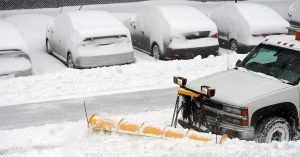
A snow plow crash killed an Easton man this week. Police are currently investigating.
As we battled snow and cold, there were two fatal snow plow accidents this week, including one death here in Massachusetts. In Easton, a snow plow hit and killed a 64-year-old man who was changing a tire on Route 138. Meanwhile, in Illinois, another man was snow blowing his driveway when a plow truck backed into him. Both men were pronounced dead on the scene.
These were not the only snow plow accidents, either. In Johnson County, Kansas, a snowplow driver veered off the road and died in a single-car crash. In New York, a state DOT snow plow and vehicle collided in the Town of Aurelius in Cayuga County. Traffic was stopped as two people were airlifted for medical treatment.
Easton Snow Plow Accident
NBC Boston reports the 64-year-old Easton man was hit about 1 p.m. Wednesday on Washington Street, which is Route 138. The victim parked his van on the street, along the breakdown lane on the northbound lane, when the passenger truck plow approached. The victim was fixing the rear tire on the driver’s side when he was hit. According to the Brockton Enterprise, police arrived to find broken vehicle parts, a pair of sneakers and other debris littering the street. The car jack, tire and van were left behind.
Neighbors witnessed the horrific crash and told NBC Boston that the victim had been kneeling down when he was hit by the plow’s blade, then dragged. One homeowner has turned over home surveillance video to help police with the investigation, according to the news station.
Police are still investigating whether the plow driver will face criminal charges. The police chief told NBC Boston that one focus of the investigation will be where the victim was at the time of the crash, whether he was in the roadway or off the roadway.
Police have not released the driver’s name, but said he remained on the scene and cooperated with the investigation.
Illinois Snow Plow Accident Kills Man
In the Chicago suburbs, there was another sad story in the Village of Libertyville. A 75-year-old man was killed Monday morning while clearing snow and ice from his driveway. According to news reports, the victim may have been snow blowing his driveway when a snow plow driver backed into him. The crash happened in a cul de sac in the 600 block of Bridle Court in the Village of Libertyville.
The man was pronounced dead on the scene and the plow driver was placed on paid administrative leave pending an investigation by the Lake County Major Crash Assistance Team began investigation.
Snow Plow Truck Accidents in Massachusetts
Snow plow truck accidents happen every year in Massachusetts and they are often fatal. Snow plow crashes can seriously injure drivers and passengers. But many snow plow crashes injure pedestrians.
Snow plow drivers in Massachusetts have a responsibility to obey all traffic laws and exercise caution, always watching for pedestrians and other vehicles.
They must meet certain requirements to clear snow. First, snow plow drivers must apply for a commercial driver’s license (CDL). Second, they must buy commercial auto insurance, along with plow equipment. Finally, the Registry of Motor Vehicles issues special snow removal plates which they must use. Yet, beyond this, there is little oversight, including no restriction on how many hours they are allowed to work.
Plow drivers can work for private companies and contract with cities, towns, the state or private businesses; they can be owned and operated by cities and towns or they can be owned and operated by the Massachusetts Department of Transportation.
Over the years, Massachusetts has seen numerous snow plow accidents lead to serious injuries and death. Causes of snow plow accidents can include drowsy driving, checking a cell phone and inexperience with the heavy machinery.
Snow plow drivers have faced criminal charges and civil lawsuits in Massachusetts. In 2016, a plow driver was charged with manslaughter in the death of a 60-year-old man he struck in Medford. A year earlier, the victim left Bread & Circus Bakery – a Whole Foods Market company – and walked across the store’s parking lot. Police allege the plow driver had been smoking marijuana prior to backing up and running over the worker.
Another tragedy came in February 2015, when a 21-year-old Fitchburg woman was killed in a snow plow accident as she walked home from a local Market Basket, where she worked. Her family filed a wrongful death lawsuit against the snow plow driver and his company, Einstein’s Inc., along with his insurance carrier, Plymouth Rock Assurance Corp.
According to the Sentinel & Enterprise of Fitchburg, the lawsuit alleged the driver had operated negligently, recklessly and carelessly and created a safety risk on public roads and highways and that the company had breached its duty to public to ensure the driver was operating safely.
If you or a loved one have been injured by the negligence of a snow plow driver in Massachusetts, our Boston personal injury lawyers can help you learn your rights for seeking compensation.
For a Free Legal Consultation, Call Breakstone, White & Gluck of Boston at 800-379-1244 or 617-723-7676.
Hands-Free Cell Phone Law Proposed in Massachusetts

Hand-held cell phone use would become illegal under new legislation proposed by the Massachusetts’ governor’s office.
Many of us expected Gov. Charlie Baker and Lt. Gov. Karyn Polito would file legislation to limit drivers to hands-free cell phone use this year. But the Baker-Polito Administration went much further last week when it filed, “An Act Relative to Improving Safety on the Roads of the Commonwealth.” In announcing the legislation, the administration reported more than 15,000 people were seriously injured in Massachusetts traffic accidents between 2012 and 2016. Another 1,820 people were killed, including 14 road workers.
The Massachusetts Legislature now has a great deal to consider in coming months. Because these proposals will impact us all, we encourage you to follow the media coverage and share your thoughts with your local legislators and town officials.
Cell Phones. In 2010, Massachusetts banned texting while driving. There have been similar proposals, but no action on handheld cell phones. Meanwhile, distracted driving accidents have increased, claiming 3,450 lives in 2016, according to the NHTSA.
The Baker-Polito proposal would require drivers who use electronic devices to go “hands-free” and make use of hands-free driving equipment, such as Bluetooth. Drivers would have to use voice commands instead of reaching for hand-held cell phones. The proposal does allow “a single tap or swipe to activate, deactivate or initiate hands-free mode.”
If this proposal is approved, Massachusetts would be the 16th state to have a hands-free cell phone law, joining all the New England states.
Primary Seat Belt Enforcement. According to the GHSA, 34 states have primary seat belt laws for drivers and front-seat passengers.
Massachusetts has a secondary seat belt law, meaning police officers cannot simply pull a motor vehicle over for a seat belt violation. A police officer must first observe another moving violation, such as speeding or running a red light.
A primary enforcement law for seat belts has been a hard sell in Massachusetts. But we urge you and your family to use the debate as a reminder to wear a seat belt every time you ride. According to the NHTSA, seat belts saved an estimated 14,668 lives in traffic accidents in 2016. Wearing a seat belt is an easy choice we can all make to protect ourselves.
Road Workers. The Massachusetts Department of Transportation would be granted authority to lower speed limits in construction zones. Fines would double in areas where workers are.
Truck Sideguards. In 2014, the Boston City Council approved a truck sideguard ordinance for all city-contracted trucks – the first in the nation. The governor’s proposal builds on this, mandating sideguards for all state-owned trucks and vehicles over 10,000 pounds. Along with sideguards, trucks must be equipped with convex and cross-over mirrors to increase driver’s visibility. If approved, trucks would have to be equipped by Jan. 1, 2020. All state and municipal contractors would have to do the same by 2022.
The sideguards are intended to protect the area between the truck’s front and back wheels, blocking it off to cyclists and pedestrians who can be caught underneath. Massachusetts has seen numerous cyclists who have been seriously injured or killed by these types of truck accidents.
Electric Scooters. The proposal would start regulating electric scooters like bicycles and allow scooter rentals to move ahead in local communities. This has been a point of contention in the Boston area as bikeshare and rideshare companies are eager to start scooter rentals here. Cities have argued that scooters are illegal because they don’t have directional signals as stated under current state law.
Ignition Interlock Devices. When drivers are convicted of operating under the influence or drunk driving in Massachusetts, they are permitted to apply for a hardship license. With this proposal, anyone who applies for a hardship license must use an ignition interlock device for a minimum of six months. The proposal also clarifies that the Registry of Motor Vehicles has authority to impose penalties if drivers attempt to drive after consuming alcohol or tamper with a device.
About Breakstone, White & Gluck – Boston Car Accident Lawyers
With more than 100 years combined experience, Breakstone, White & Gluck specializes in representing individuals injured in car accidents, truck accidents and other catastrophic collisions. If you have been injured, learn your rights at 800-379-1244 or 617-723-7676. You can also use our contact form.
Breakstone, White & Gluck Supports the Equal Justice Coalition’s Walk to the Hill 2019
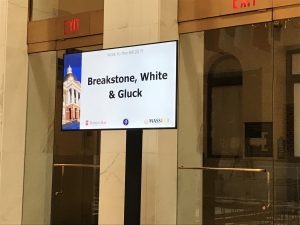
Breakstone, White & Gluck participated and supported the Equal Justice Coalition’s Walk to the Hill 2019 at the Massachusetts State House.
Breakstone, White & Gluck was pleased to support and participate in the Equal Justice Coalition’s Walk to the Hill, seeking increased funding for civil legal aid in Massachusetts. Attorney David W. White joined hundreds of lawyers at the Massachusetts State House, urging legislators to help fund free legal services to residents who cannot afford an attorney on their own. Many Massachusetts residents are not familiar with the coalition until they need help with a landlord dispute, consumer fraud or another non-criminal matter. Then the coalition’s services become critical because when someone faces criminal charges, they have the right to an attorney. But those who need representation in a civil matter are on their own. If they can’t afford a lawyer, the person could suffer devastating losses, personally and financially. With more funding for civil legal aid, the coalition and other legal aid organizations can help more individuals and families stay on track, in their homes, working, receiving medical treatment or going to school without interruption.
The Equal Justice Coalition was created in 1999 by the Boston Bar Association, the Massachusetts Bar Association and the Massachusetts Legal Assistance Corporation. Representatives from these programs participated in a speaking program in the Great Hall at the State House, before attorneys began visiting lawmakers’ offices. Speakers included Louis Tompros, chair of the Equal Justice Coalition; Lynne M. Parker, Executive Director of the Mass. Legal Assistance Corporation; Supreme Judicial Court Chief Justice Ralph Gants; Christopher Kenney, President of the Massachusetts Bar Association and Jacquelynne Bowman, Executive Director of the Greater Boston Legal Services.
FDA Proposes Changes to 510(K) Medical Device Approval Process
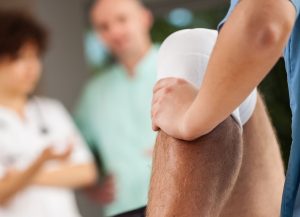
The Attune Knee System was approved through the FDA’s 510(K) process. Breakstone, White & Gluck is currently representing patients who have suffered Attune knee replacement failures. Free Consultation: 800-379-1244.
In 2019, the public can expect to learn more about the Food and Drug Administration (FDA)’s plans for improving the 510(K) approval process for medical devices. Instead of improving the quality of life for patients, too many medical devices are causing injuries and even death. Many of these medical devices were been approved through 510(K).
Too often, we hear about medical device injuries in the news. At Breakstone, White & Gluck, our attorneys represent patients injured by defective medical devices and other unsafe products in Massachusetts and Rhode Island, from Boston to Worcester to Providence. Our attorneys know each news story represents many more patients who have been injured.
But just how many? More than 1.7 million people have suffered injuries from medical device failures over the past decade, according to a 2018 Associated Press report. Nearly 83,000 people died. These are giant and unbelievable numbers, especially when you consider that medical devices undergo a federal approval process which should protect patients.
How the FDA 510(K) Process Works
Since 1976, manufacturers have been able to short-cut the FDA approval process. If a manufacturer can demonstrate their medical device is “substantially equivalent” to an approved medical device, they can apply through the 510(K) approval process. The manufacturer has to submit paperwork, explaining the similarities between medical devices, but they are not required to conduct additional clinical testing – even for devices which are surgically implanted such as knee and hip replacements.
FDA Proposal Calls for 10-Year Restriction
While the FDA has long been committed to the 510(K) approval process, many have argued the process needs to be more focused on patient safety. After many years of complaints, the FDA is now proposing a change to only allow manufacturers to use the 510(K) approval process when they base their applications on medical devices approved in the past 10 years.
The FDA said this change will modernize the process and ensure products and technologies continue to improve.
Here is a point that supports change. While there are 4,000 medical devices in the agency’s database, just six types have caused 25 percent of all injuries between 2008 and 2017. These include defective hip replacements, including the DePuy metal-on-metal and other hip implants, accounting for more than 103,000 injury reports. The other medical devices: spinal stimulators, surgical mesh, defibrillators, implanted insulin pumps and insulin pumps with sensors. These figures also come from the Associated Press.
Over the next few months, the FDA is taking public comment on other questions, such as should there be a public list of devices or manufacturers who make technologies that rely on devices approved more than 10 years ago? Or what would be an appropriate time period? Read more: FDA’s questions for the public.
Common Medical Device Defects and Injuries
Breakstone, White & Gluck specializes in representing those injured by medical device failures in Boston, Worcester and across Massachusetts and Rhode Island. If you have been injured, our attorneys can advise you of your legal rights for seeking compensation. Our goal is to help clients obtain prompt medical treatment and then, full compensation for financial losses, such as lost wages. Patients may also be entitled to damages for pain and suffering.
Our lawyers are experienced in handling medical device claims involving:
Knee implants. One knee replacement with a high rate of failure is the Attune Knee System, which is stabilized by a cement fixture. Patients can suffer physical pain when the cement loosens.
Hip implants. DePuy issued a recall for its ASR XL Acetabular System metal-on-metal hip implants in 2010. But many other implants followed, including the Stryker Rejuvate Modular and ABG II Modular-Neck Hip Stems, Zimmer and Smith & Nephew. Read more about what to do if you have a defective hip implant.
Surgical mesh. Patients have suffered complications after being treated with surgical mesh implants during hernia repair procedures. There have been so many injuries that the FDA has issued an advisory warning patients about the severe pain and long-term complications that can result. One type of surgical mesh which has caused injuries is the Ethicon Physiomesh® Flexible Composite hernia mesh.
Boston Medical Device Injury Lawyers – Free Legal Consultation: 800-379-1244
Learn your legal rights if you have been injured as a result of a medical device failure. For a free legal consultation, contact Breakstone, White & Gluck at 800-379-1244 or 617-723-7676 or use our contact form.
Massachusetts Property Owners and Drivers Have a Responsibility to Clear Snow
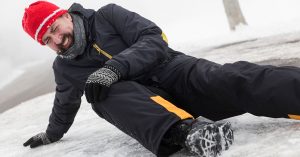 The forecast is calling for snow in Boston. Get your shovels ready. Clearing snow and ice isn’t just considerate. It’s a responsibility for property owners and drivers under Massachusetts law.
The forecast is calling for snow in Boston. Get your shovels ready. Clearing snow and ice isn’t just considerate. It’s a responsibility for property owners and drivers under Massachusetts law.
As personal injury attorneys, we have represented many people who have slipped on snow and ice across Massachusetts and never saw the danger or risk. Slips and falls can happen on both residential and commercial property, on walkways, parking lots and unsecured railings. These injuries can be long-lasting and often leave a person unable to work for a period of time. As a property owner, remember you are in control of your property. Shovel and monitor your property so no one is injured.
Massachusetts Property Owners Must Shovel
Massachusetts law recognizes that property owners have a responsibility to clear snow and ice – now. But this was not always true.
In 2010, the Massachusetts Supreme Judicial Court ruled in the case of Papadopoulos v. Target Corporation, SJC-10529 (July 26, 2010). This ruling changed everything for property owners and those who are injured on snow and ice.
In Papadopoulos, the plaintiff fell on ice in a parking lot outside a Target department store at the Liberty Tree Mall in Danvers. Claims were brought against the Target Corporation and Weiss Landscaping Company, the contractor in charge of snow and ice removal.
In its ruling, the Supreme Judicial Court abolished the long-standing distinction between “natural” and “unnatural” snow accumulations. In the past, the cause of snow accumulation was significant in determining whether those injured could bring a claim against the property owner. If snow and ice had naturally accumulated, the property owner may not be held liable for injuries. But property owners could be held liable for unnatural accumulations, such as snow thrown by a plow or shovel.
This was known as the “Massachusetts rule,” of natural accumulation. It was rejected by every other high court in New England, according to the Supreme Judicial Court’s decision.
With this decision, the Supreme Judicial Court wrote that property owners will now be held to the same duty of car to act as a reasonable person, regardless of how snow and ice forms to create a property defect.
For property owners, the takeaway is clear your driveways and walkways. Don’t let snow and ice accumulate. If you do, someone could be seriously injured and you could be held liable.
- Clear snow during and after snowstorms. Salt regularly. Start early into a snowstorm. After a snowstorm, monitor the ice accumulations on your property. Your property may also need attention for the next few days.
- Safety for your visitors. Approach your property by foot. Walk up your driveway and on any paths. Test how safe these areas are for your friends, family and delivery professionals.
- Porch safety. If you have a porch, keep it clear of snow and ice during the winter, so melting does not damage or weaken the wood. Remove furniture from your porch so you have no trouble shoveling.
Massachusetts Drivers Must Shovel, Scrape and Clear
 The Massachusetts Driver’s Manual states drivers should remove snow and ice from their vehicles before driving. We urge you to plan extra time. Clear all windows, windshield wipers, headlights and brake lights, so your vehicle is fully operational.
The Massachusetts Driver’s Manual states drivers should remove snow and ice from their vehicles before driving. We urge you to plan extra time. Clear all windows, windshield wipers, headlights and brake lights, so your vehicle is fully operational.
Take extra care to clear your vehicle’s roof. Failure to do so can send snow onto the car behind you, throwing the driver off or causing a car accident.
Drivers can be cited for failure to clear snow in Massachusetts. Police can fine drivers with impeded operation if they drive with snow-covered windows. This offense is punishable by a $40 fine.
When a driver fails to clear their roof, they may face a $200 fine for driving with an unsecured load. Drivers of commercial trucks, passenger trucks, vans and other vehicles traveling with snow and ice and other unsecured loads are highly dangerous, especially in winter conditions. Slow down and create space between you and any vehicle which makes you feel unsafe. Move to another lane. Write down the driver’s license plate and contact police.
A driver’s failure to clear snow can lead to a traffic citations, but also criminal charges and liability in a civil case if someone is injured.
Boston Snow and Ice Accident Lawyers – Free Legal Consultation: 800-379-1244
Breakstone, White & Gluck of Boston has over 100 years combined experience representing those injured by the negligence of commercial and residential property owners. We have expertise in handling cases involving snow and ice falls, porch collapses and landlord negligence. Our Boston personal injury attorneys have represented clients across the state of Massachusetts, including Boston, Brockton, Hyannis and Cape Cod, Fall River, Framingham and Worcester.
For a free consultation, call our office at 800-379-1244 or 617-723-7676 or use our contact form.
Massachusetts Superior Court Judge Questions Long-Standing “Transitory Water” Doctrine
 For decades, the Massachusetts courts have adhered to the “transitory water doctrine.” Simply put, under this common law standard, Massachusetts property owners have generally been shielded from liability in slip and fall cases when an injury results from normal use in wet weather. For example, a customer who wears boots in the snow and tracks water into a store, causing another customer to slip.
For decades, the Massachusetts courts have adhered to the “transitory water doctrine.” Simply put, under this common law standard, Massachusetts property owners have generally been shielded from liability in slip and fall cases when an injury results from normal use in wet weather. For example, a customer who wears boots in the snow and tracks water into a store, causing another customer to slip.
Established more than 40 years ago, the transitory water doctrine has set the legal standard for property owners. With no incentive to avoid liability, large commercial property owners were virtually free from worries about injuries caused by water tracked in from outside. Make no mistake: many people have been badly hurt right after crossing the threshold of a store, where the water and grime are most concentrated.
But this may change, after a recent ruling by Superior Court Judge Cornelius J. Moriarty II.
Judge Moriarty recently ruled in Holden v. Wal-Mart Stores East, LLP. In February 2016, the plaintiff alleged she stepped into the Wal-Mart in Hanover and slipped on water that had accumulated on the floor. The spot where she slipped was between the door and a mat, which would have prevented the fall, but which was located a few feet from the doorway.
Wal-Mart argued the transitory water doctrine barred the plaintiff’s claim and moved for summary judgment. But Judge Moriarty denied this motion, writing that the transitory water doctrine can no longer be considered good law after the Supreme Judicial Court’s 2010 ruling in Papadopoulos vs. Target Corporation, 457 Mass. 368 (2010).
“Whether Wal-Mart made reasonable efforts to protect the plaintiff against the danger is for the jury to determine,” Moriarty wrote. The judge reasoned that Massachusetts law is moving towards a unified standard or reasonable care for property owners, and that old common law exceptions are being eliminated.
In 2010, the Supreme Judicial Court of Massachusetts abolished the century-old double standard governing who could bring claims for injuries resulting from slips and falls on snow and ice. Now, property owners have a responsibility to use reasonable care in clearing snow and ice.
Prior to Papadopoulos, Massachusetts law distinguished between injuries suffered by falls on “natural” and “unnatural” accumulations of snow and ice. Previously, a property owner was not liable for injuries caused by slip and falls on natural accumulations, so property owners had no legal incentive to clear snow in some cases. But property owners could be held liable if someone was injured by an “unnatural” accumulation, such as snow dropped by a plow or ice from a leaking gutter.
The Holden case is not yet resolved. If the case does result in a verdict against Wal-Mart, then Wal-Mart will have the option of appealing the summary judgment decision.
We believe that this is a sensible decision by Judge Moriarty, and that a uniform standard of reasonable care under all circumstances for property owners will lead to greater safety and fewer personal injuries.
Free Legal Consultation: Breakstone, White & Gluck
With more than 100 years combined experience, Breakstone, White & Gluck specializes in personal injury and medical malpractice cases in Boston and across Massachusetts. For a free legal consultation with our attorneys, contact us at 800-379-1244 or 617-723-7676 or use our contact form.


